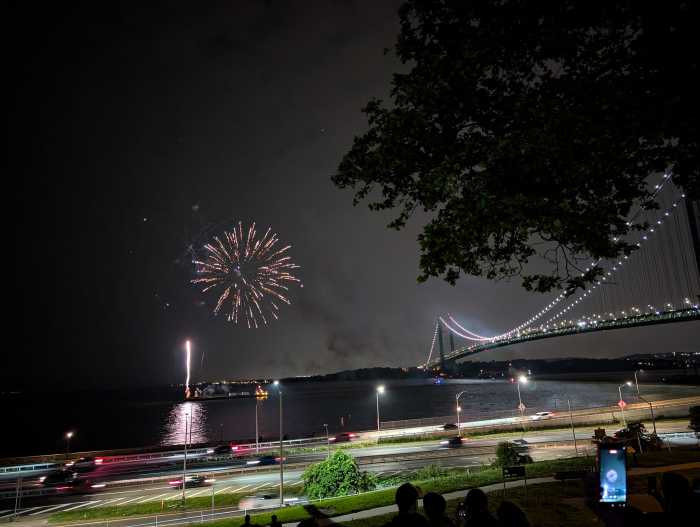Ellie Dehn and Wendy Bryn Harmer in Bard SummerScape’s production of Carl Maria von Weber’s “Euryanthe.” | CORY WEAVER
Throughout the 19th century, opera composers strived to break away from the “number opera” format — a series of separate musical pieces in conventional forms interspersed with recitative or dialogue that moved the action forward. Through-composed operas created set pieces that carried the dramatic action forward without stopping the orchestra or the action, a development that curtailed endless musical repeats and extraneous vocal display.
Giuseppe Verdi and Richard Wagner are cited as the great game-changers of 19th century opera. Yet Carl Maria von Weber’s innovations paved the way for Wagner, and Verdi was influenced more by Gaetano Donizetti than any other contemporary composer.
The first US staging in a century of Weber’s “grand, heroic” Romantic opera “Euryanthe” (1823) provided the centerpiece of this summer’s Bard SummerScape in upstate Annandale-on-Hudson. The performance demonstrated clearly both the profound merits and the fatal flaws in Weber’s seminal work, in which he jettisoned the spoken dialogue of “Der Freischütz” for a through-composed format where musical harmony and structure follow the emotions of the characters rather than operatic convention.
Before there was Wagner or Verdi, there were Weber and Donizetti
The orchestral fabric is unbroken, with a freer use of harmony — including daring chromaticism that influenced Wagner. In fact, Wagner’s “Lohengrin” is practically a Technicolor remake of Weber’s “Euryanthe” – both feature a virginal soprano and a knightly tenor pitted against a villainous baritone and a witchy dramatic soprano who dupe the heroine into revealing a forbidden secret. Wagner co-opted Weber not only by borrowing from him but also by defining him as a transitional musical prophet — John the Baptist to his own Jesus. Critics blame Helmine von Chézy’s convoluted, fantastical libretto as the reason why “Euryanthe” is more written about than performed.
Kevin Newbury’s production reinterpreted the medieval chivalric tale as a Victorian ghost story with symbolic psychological undertones substituting for medieval fantasy. The ghost of Emma (whose suicide is the forbidden secret and whose ring must be cleansed for her soul to be saved) appears at key moments. Her underground tomb is present in every scene — her fate underlies the story.
The serpent that attacks the hero and heroine in Act III is a gnarled, phallic tree with tentacle-like roots that descends from above when the hero Adolar attempts to ravish Euryanthe (who he believes has betrayed him). In this case, the psychology was as confused as the staging. Otherwise, Newbury’s direction is intelligent and largely non-interventionist.
Ellie Dehn as Euryanthe began with a clouded, strained tone that gradually gained greater clarity and ease. Her round-toned lyric soprano was comparatively weak at the bottom; full-throated high notes were better controlled.
William Burden’s Adolar, portrayed as a wounded war veteran, also sounded dry and effortful at the beginning but warmed up by the second act. His dulcet Mozart tenor has retained elegant clarity of tone while gaining needed heft and depth. Burden’s handling of German text was stylish.
As a platinum blonde vixen Eglantine, Wendy Bryn Harmer’s brightly metallic tone was secure but could turn glassy and edgy under pressure. She struggled with the florid climax of Eglantine’s Act I scena. Handsome bass-baritone Ryan Kuster cut a dashing figure as the villainous rival Lysiart, but he looks younger and prettier than he sounds. I heard a light lyric baritone artificially darkened and puffed up in a role two sizes too heavy for him. I was impressed by Peter Volpe’s effortlessly expansive deep bass as King Ludwig — I’d like to hear him in Wagnerian repertory.
Dr. Leon Botstein’s advocacy of the work was not helped by his conducting. He failed to pick up on shifts in tempo, maintaining a dull middle ground throughout. There is more color and contrast in Weber’s score than he elicited from the diligent, responsive American Symphony Orchestra.
The plot takes too long to develop, with dull passages in Acts I and II, but Act III has greater musical and dramatic intensity. Weber’s pursuit of homogenous musical unity in “Euryanthe” robs the work of the musical highlights of “Der Freischütz,” but it is more dramatically viable than many works that are lesser musically but more frequently revived.
Verdi’s “Rigoletto” (1851) marks the beginning of the composer’s mature middle period. Verdi took the structures of 19th century bel canto and stripped them down for action. The hit tunes and theatrical tension coalesce in forward-moving synergy from the first bar to the final chord.
Will Crutchfield chose “Rigoletto” as the companion piece to Donizetti’s “Lucrezia Borgia” for this summer’s “Bel Canto at Caramoor” series. The two operas are based on thematically related Victor Hugo tragedies: both the outwardly deformed Rigoletto and the inwardly twisted Lucrezia Borgia destroy the one thing they truly love –– their own children. Verdi used Donizetti’s 1833 opera as a model when adapting a Hugo tragedy for “Rigoletto.” Donizetti, in 1840, cut Lucrezia’s florid rondo finale, replacing it with an intimate duet where the tenor dies in his mother’s arms, which is directly mirrored in Gilda’s heartbreaking “Lassù… in cielo” death in the final scene of “Rigoletto.”
Crutchfield stated in press releases that “Rigoletto” would be performed in bel canto style, but that was inconsistently applied depending on the skill set of each performer.
The best reason to revive “Rigoletto” is the availability of a superb Verdi baritone for the title role –– and that Caramoor had in Stephen Powell. He didn't embellish the vocal line, he only interpolated the traditional high notes in “Pari Siamo” and the “Sì vendetta!” duet. His portrayal is the classic line of Tibbett, Warren and Merrill. Powell’s rich mahogany tone is full, even and unforced from top to bottom – more lyrical than a Cornell MacNeil or Gobbi but fully responsive to the role’s demands.
Georgia Jarman’s Gilda was sung accurately and firmly, with a bright generic lyric-coloratura soprano. Her ornamentation consisted of a fussy new cadenza at the conclusion of “Caro Nome” that was less musically integrated than the traditional one.
Rossini specialist John Osborn as the Duke of Mantua was the only performer who consistently added cadenzas, grace notes, and turns to his music. He sounded mildly indisposed –– allergies? –– in the first two acts, with several mini-cracks in the passaggio. He then settled down for an impressive “Parmi veder le lagrime,” and his “La donna é mobile” brought down the house.
Jeffrey Beruan’s smooth oily bass sounded just a little too attractive for the sinister Sparafucile. Nicole Piccolomini’s resonant, hard-edged mezzo made for an effective Maddalena –– especially coupled with her dark, slinky good looks.
The orchestral sonority of the Orchestra of St. Luke’s was light, transparent, and less weighted in the strings. Crutchfield followed Verdi’s metronome markings, which can be slower, yet the music seemed to move faster with unforced elegance.































